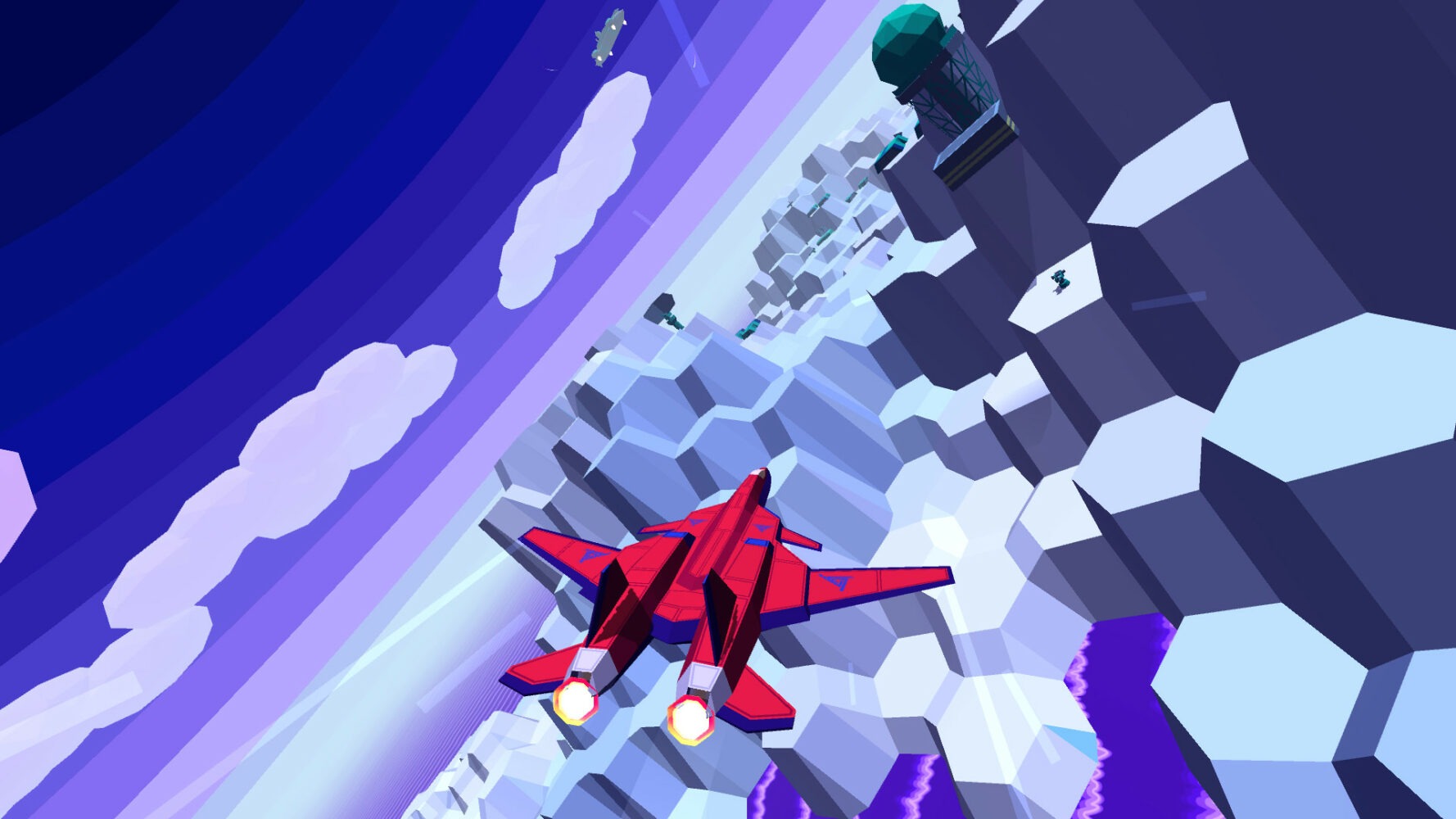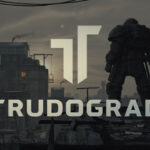Sky Rogue is an uncomplicated game. It’s a game with simple gameplay and simple graphics with hardly an excuse plot to its name. However, simple is not the same as bad. The simplicity has allowed developer Fractal Phase to focus on the important parts.
You want a good dogfight? You want to fly around and blow stuff up in an aggressively 80s way? You want to feel like an ace pilot? Sky Rogue might just be for you.

Dogfights and Flying Aces
Sky Rogue utilizes a mission-based structure. You launch off of your flying aircraft carrier over a procedurally generated small archipelago. The islands are covered in military fortifications, bunkers, anti-aircraft weaponry, and all kinds of other nifty military targets. There are boats in the waters, usually decked out with their own weapons. There are oil rigs with their own turrets. And, of course, the enemy also possesses flying aircraft carriers. You have a plane with infinite ammo. Your job is to use this to make the enemy no longer have any of those things that I’ve just listed.
Well, there is more to it than that. Each mission has a primary target, sometimes a group of them, and you cannot complete the mission until those in particular have been blown to smithereens. Your primary target can be just about anything that normally appears in a mission, from ground structures to certain fighter planes. Everything else is secondary to that objective.
But just because it’s secondary doesn’t mean you shouldn’t do it first. Because, as you may have guessed, Sky Rogue is a Rogue-lite game. If you’re unfamiliar, the basics of the genre involve some level of procedural generation and dying having significant, usually permanent consequences. And death in Sky Rogue ends the overall operation, costing you any upgrades you’ve purchased in the meantime.
But how do you get upgrades? Buying them. And how do you get money? Blowing up secondary targets. And that provides the central risk/reward system around which the whole game is built. By destroying enemies, you receive both funds and tech points. Funds are spent to upgrade the weapons and planes you own, increasing things like your damage and range or your health and speed, respectively. Tech points are spent post-mortem to acquire permanent weapon and plane unlocks.
So if you stick around in a mission, you risk dying and losing all the progress you’ve made on the operation as well as the upgraded weapons and planes you’ve bought. But if you only do the primary objective and immediately return to base, you won’t have enough funds to upgrade yourself and you’ll quickly find yourself overpowered and overwhelmed by the enemy forces.
There’s also no healing items or health drops from defeated enemies. The only way you can heal is to return to your flying airship and land for repairs. This costs some of that money you earn through combat, so you can’t simply exploit this for infinite health. And returning to base is how you complete a mission. In other words, once you’ve destroyed the primary target(s), you no longer have any way to heal yourself. So it might be wise to wait until you think you’ve earned enough money and tech before you complete a mission.

There’s a good variety of weapons. Mostly missiles, or at least I almost exclusively had missiles among my weapon unlocks, but guns are also an option. As well as bombs, for when the enemy is directly below you. Weapons are equipped either between missions or when you stop at your base to heal. So if you’re fighting a mix of ground and air enemies, you could theoretically switch loadouts after dealing with one set of enemies to better take on the remainder.
The controls are fairly solid. Not necessarily as tight as I would have liked. Especially on Mouse and Keyboard, I frequently found them to be less responsive than I wanted. I personally recommend using a controller if you can. I suspect that people with more experience with flight sims than I have will get a lot more out of the controls than I do.
Most of your weapons use a target locking system to home in on enemies, little aiming needed. However, you have to be close enough for your plane to lock on to them. Fortunately, your HUD tracks your distance to targets for you. You also need to be, you know, actually aiming at the target. You can’t just fire off missiles behind you. That would be silly. The missile that explodes into a series of cluster missiles is deadly serious.
Also Read
Transmogrify PC Review: The Best Way To Defeat An Enemy
A video game protagonist wakes up in an on-fire science lab with nothing but an AI and a high-tech gun to…
Defy the Gods as a Witchy Moon Goddess in Hades 2
Greek-mythology-themed roguelike Hades is getting a sequel, but developer Supergiant has kept the details scant beyond a Hades 2 reveal trailer…
Not all of your weapons are homing, however. Guns, obviously, do not have bullets that chase targets as awesome as that would be. And there are unguided missiles as well. (I’m not sure why the bombs you drop are listed as unguided. As opposed to what? Have we figured out how to redirect gravity while I wasn’t looking?) The HUD keeps track of this for you as well. Switching which weapon you have equipped changes your display to show a ring. This ring shows where you’re aiming so you can ensure you’re pointing your explodey bits at the enemies.
Sky Rogue is difficult but forgiving. You’re alerted to the general direction of enemies and you are always told when an enemy is locking on to you or when missiles are inbound, as well as the direction, so you can use your dodge to avoid them. Enemy guns are fairly inaccurate, but a storm of bullets can still prove problematic to avoid if there’s enough of them.
Also, most weapons have approximately the same range. So if you can target an enemy, they can target you too, provided they’re facing you. Of course, none of the enemies I encountered can dodge or deploy flares to throw off missiles, both of which the player can do. So it’s not exactly a fair fight, but there’s always danger to getting close enough to an enemy to attack.
And, of course, crashing your plane is instant death. Though I’ve noticed that destroyed enemies, no matter how intact, have not yet killed me when I ran into them. I would recommend against testing this against actual structures though. I don’t think you could survive hitting an oil rig, no matter how burned it is.

Retro-Inspired but not Imitating
Sky Rogue has a very strong aesthetic. It’s very clearly reminiscent of older retro games without actually trying to recreate their look. Not that you really could in 3D, but there wasn’t even an effort to imitate pixel art or similar. But the water texture on the ocean looks like it came straight from an old arcade machine. The harsh gradient of the skybox is striking.
The structures and the island itself are simple. The islands are composed of solid-colored hexagons with rounded edges. The hexes are arranged at different elevations and placed together just enough to look convincingly like an island. There aren’t any trees or rocks or other things you would expect to do the landscape. It’s just water and ground. And this works much better than it sounds like it should.
The planes aren’t the most detailed models I’ve ever seen, but the detail they do show is well done. They’re far more intricate than the landmasses, but not enough that they clash stylistically. And since you’re going to spend the game paying attention mostly to the planes, it makes sense to make them look really good.
Enemy structures lie somewhere between the absolute simplicity of the island and the polished detail of the planes. They’re definitely not the kind of models that will knock your socks off, but they look good and mesh well with the aesthetic. It’s easy to distinguish buildings by silhouette, which is always a plus. And while the stationary ground defenses—such as the surface-to-air missiles or the gun turrets—are small, they’re also bright red and stand out against the ground. And your targeting system will highlight them for you if you’re close enough.
The sound design is crunchy in a way that’s hard to describe. Much like the graphics, the sound effects are clearly imitating retro sound effects, but with modern equipment, so they’re far too good to have actually been used in the imitated time period. There’s a sort of static muffling effect over the sounds if that description makes sense. It helps bring the aesthetic together without being annoying or distracting.
Speaking of things that can get annoying, I think there’s only a single music track during missions. And it’s a great track, don’t get me wrong, and I tend to tune it out easily enough in the heat of battle, but it is also a single song. If you play it enough, you’re going to get sick of it. There’s other music for menus or loadout screens, and maybe if I was good enough to reach the later stages of a run I’d hear more music. But it is something to keep in mind.
I’ve mentioned the HUD a few times in the Gameplay section, but it bears repeating that the HUD tracks everything you need to know very well without really obscuring anything. However, those markers rotate around your screen and the labels are oriented the same way as the arrows, so as you fly around it’s possible for some of the labels to become illegible. And while incoming missiles have their own arrow and color to distinguish them, enemy fighter planes are all functionally identical in their markers. So you won’t be able to really tell what an enemy is until you’re facing them, and they might have weapons you weren’t expecting, or coming towards you guns blazing. The HUD can also be hard to read with certain cosmetics, as the white text can blend in with white planes or white home bases.
As far as I can tell, there isn’t much of a story beyond ‘Those guys you don’t like have combat vehicles, go shoot at them.’ Each playthrough gets its own randomly named operation title XCOM style, and the islands are named when you deploy, but there isn’t much context for the conflict or your success in mowing through their ranks. You can find information in the Aeropedia discussing the collapse of some organization and how the splintered remnants have started producing their own planes, but I can’t say with certainly if those factions are fighting or just supplying the combatants.

Conclusion
Sky Rogue isn’t very deep, but it is engaging and fun. It’s a rogue-lite heavy on the lite. If you need to zone out for a while or just play a single five-minute mission, you won’t go wrong. If you’re looking for something to really get invested in, you might want to look elsewhere. But it definitely has that ‘just one more level’ component to it if that’s what you’re after.
But I know that I want to experiment with a few more loadout and plane combinations.
Our Rating
Graphics
Controls
Story










